Our content is reader supported, which means when you buy from links you click on, we may earn a commission.
Instructional Design Principles: Learn the Essentials to Create Effective Online Training

Do you want to create more effective online learning opportunities and a better learning experience for students?
Many course designers and course instructors start out excited to share what they know, only to wind up frustrated with the results they get. Others struggle to even get started designing an eLearning course.
Fortunately, there are some tried and true methods for building a training program that really works.
The field of instructional design has the answers you need to succeed in course design. By the end of this article, you will have a better grasp of how to take advantage of instructional design best practices to teach online.
What is Instructional Design?
According to Instructional Design Central:
“instructional design is the process by which learning products and experiences are designed, developed, and delivered. These learning products include online courses, instruction manuals, video tutorials, learning simulations, etc.”
It’s almost certain that you’ve experienced the results of instructional design in your life, both in the field of education and in the business world.
Both organizations and the individual course creator have major incentives to find and utilize the most effective methods to teach information to others.
Whether for higher education, professional development, or personal interest, people need to learn. The field of instructional design seeks to meet that need as efficiently as possible.
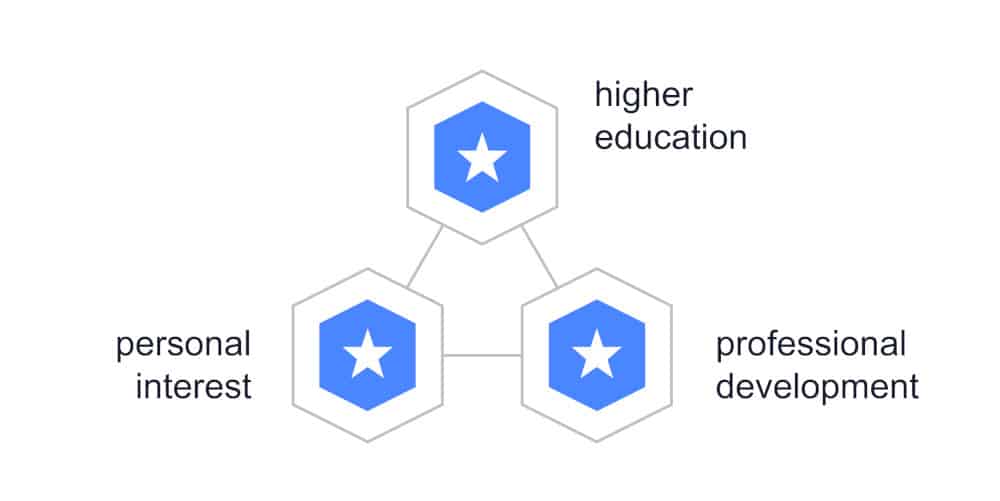
The majority of professionals who seek to teach information take advantage of at least some of the principles of instructional design. These include online trainers, course creators, course instructors, and course entrepreneurs.
They use instructional design because it is proven to work, much like how teachers use the principles of pedagogy when designing their lessons.
Just like traditional teachers, you don’t have to reinvent the wheel when creating your eLearning course. You can draw on the accumulated knowledge and research of instructional design to make your training program as effective as possible.
There are multiple approaches in instructional design, which means you will find some variation in design models. However, they all tend to include some basic components, like analysis, design & development, and evaluation.
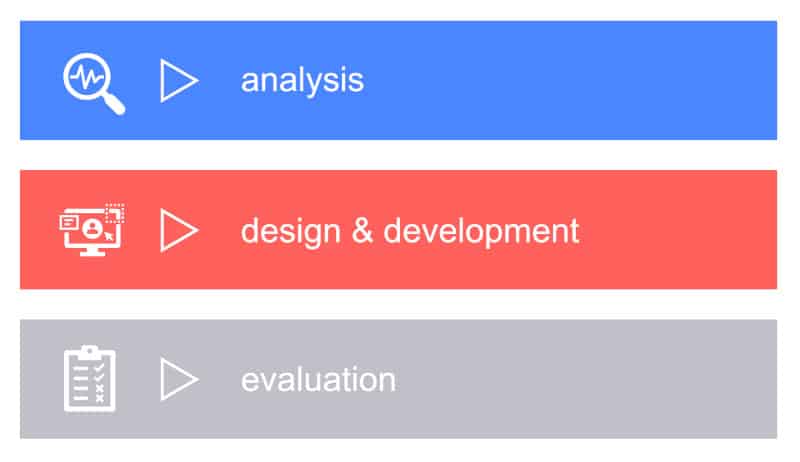
Let’s go through the 3 main components of instructional design next.
Analysis
You need to know your goals before you start designing your course. The analysis includes determining the needs of those you are teaching and the reason why you’re designing the course in the first place. You can conduct a needs analysis test to find out what your students need from your course.
Design & Development
Once you know what you want to accomplish, you can begin to design your instructional materials and course content. Certain delivery methods will be more appropriate than others for achieving your desired outcome.
It’s at this stage where you create things like lesson plans, curriculum, presentations, and all the other materials you will need in your training.
Evaluation
Creating the right instructional materials and lessons takes trial and error. You have to evaluate your work to see if it accomplished your objectives.
Can you identify a measurable impact that resulted from the training?
Evaluating allows you to seek what worked and what didn’t. That way you can improve the training moving forward and encourage full participation from learners.
What is the Instructional Design Process?
You want to create the best eLearning course you can. So, how do you accomplish this goal?
By employing the instructional design process, you can improve learning outcomes and steadily improve your ability to create high-quality courses.
There are numerous instructional design models out there.
And it’s easy to understand why.
There are many different ways to learn and different methods work better for different situations. But most of them are structured based on the fundamentals outlined above.
To expand on these basic ideas, let’s look at how the instructional design process is applied to the development of an eLearning course. There are four main areas in its application which we’ll go through one-by-one here:
1. Determine what your goals are.
Designing an eLearning course without specific learning goals in mind is a recipe for failure.
You need to know what goals you want to achieve so you can design the appropriate materials and lessons to achieve those goals. If you’re planning to create a course on how to make pizza, you need to identify what the goals of the course are.
Obviously, the overall goal is for the learner to make a pizza. But there are sub-goals within that big goal.
To make a pizza, they need to learn how to make the dough, make the sauce, top the pizza, and cook it.
You can see how the lessons and instructional materials start to develop naturally once you identify concrete goals. These goals translate easily into different sections of the course. And you can use them while developing your course outline.
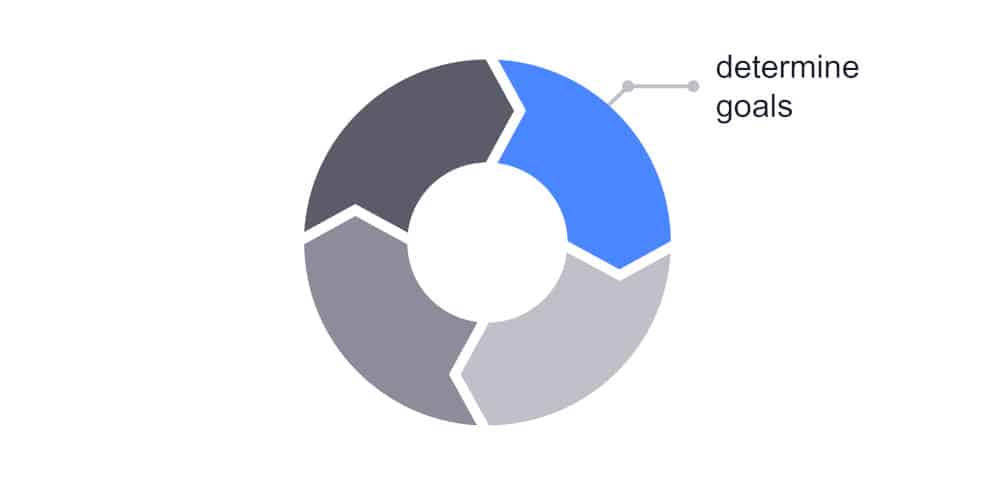
2. Engage the learner.
Too many instructors make the mistake of transferring their existing teaching materials directly to online sessions without taking advantage of the possibilities of eLearning.
Reading PowerPoint slides is not engaging. But if you add visuals, videos, and audio to your course, you start to add more interest to your lesson.
You can also consider eLearning gamification as a means to add more interactivity to your course.
You may even want to make it usable on mobile devices since mobile eLearning is really taking off.
Just be careful not to go overboard when it comes to the layout and design of your course. You may want to look into the C.R.A.P. method of design (yes, that’s a real thing). The most important thing to realize is that too much can become distracting.

3. Make the content relevant and targeted.
Part of the analysis process includes learning as much as you can about the learners you are teaching. Once you know where they are coming from and what they want and need, you can design content that is relevant and targeted to them.
For instance, if you are teaching kids how to make pizza, you’re going to use a different language than you would for teaching the elderly. Make sure to include relevant content for your target audience.

4. Communicate clearly and logically.
Essentially, you are trying to communicate information to the learner. That means using language appropriate to their level that follows a logical progression.
For instance, teach them how to make the dough first, then sauce, and so on. Don’t mix it all together because it will cause confusion.
The logical progression is important in the actual design of your course, too. Make navigation easy to understand so they can progress without getting lost or confused. If you’re using an online course platform then the platform will already offer structured navigation and simple menus to help guide your users.
As you can see, instructional design principles keep your lesson planning and design grounded in solid principles. You understand why you’re doing what you’re doing. You can expect what you create to function as you intended.
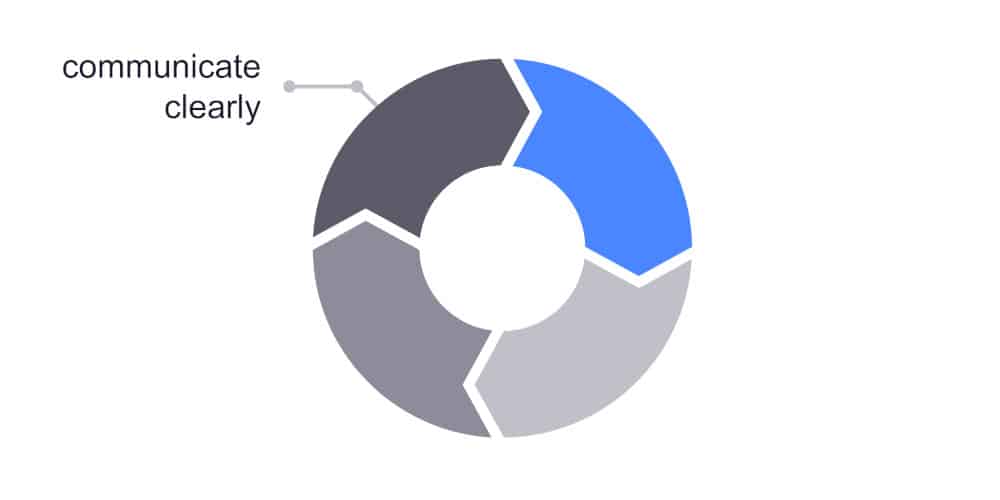
Why Use the Instructional Design Process for eLearning?
Instructional design existed long before eLearning was a possibility.
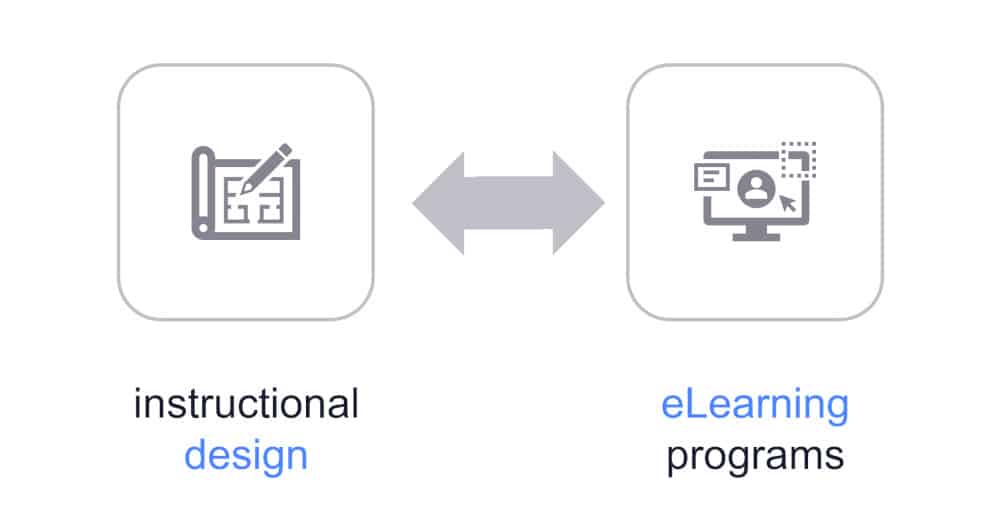 But the methods used in instructional design have transferred quite well to the online world. They have even adapted and improved in certain ways to take advantage of the possibilities of eLearning.
But the methods used in instructional design have transferred quite well to the online world. They have even adapted and improved in certain ways to take advantage of the possibilities of eLearning.
You don’t have to become an expert in instructional design right now to take advantage of these methods, either. As the examples above demonstrate, just applying basic instructional design principles to course development can help you achieve your goals more effectively.
Instructional design will help you build the best possible eLearning course you can by providing a framework for you to create your course from.
Review methods and guidelines before you start, refer to them as you are in development, and use them to edit the finished product. You can even use them to troubleshoot issues that you run into once you go live with the course.
Pros and Cons of eLearning Instructional Design
You can probably tell that I’m a fan of instructional design. But even with this inherent bias, I want you to be able to make your own decision. Here are some of the pros and cons of using instructional design for eLearning:
Pros:
- Create more effective courses. Your course outcomes are going to be more effective if you use instructional design principles.
- Improve as an instructor. Instructional design gives you a way to identify issues with your courses and correct them to improve your professional development.
- Numerous models to choose from. There are multiple instructional design models you can incorporate into your development process.
- Encourage you to take full advantage of online learning capabilities. The more thoughtful approach to course design encourages you to take advantage of audio, video, images, data tracking, follow-ups, and more to improve the learning experience of students.
Cons:
- Changing your established methods. Instructional design will naturally encourage you to make changes to how you develop courses.
- Slower initial course development. You will need to learn new methods and approaches, which will initially slow down your development speed. However, as you become familiar with the methods your speed will actually increase.
Top Instructional Design Models
There are multiple instructional design models. Some of these include:
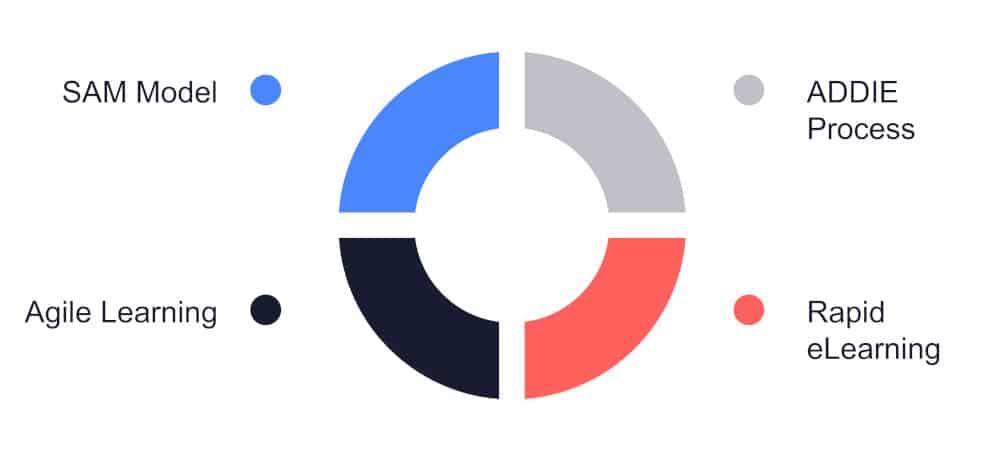
ADDIE Process
The ADDIE process consists of five stages; analysis, design, development, implementation, and evaluation. In general, you are expected to complete each stage in order before moving on to the next stage.
Rapid eLearning Design
Rapid eLearning design attempts to speed up the instructional design process so that you can produce eLearning courses more quickly and inexpensively. These strategies can really speed up the process of course creation when you need to create multiple courses.
Agile Learning Design
Agile learning design is similar to rapid eLearning design in that it attempts to speed up the process. This method draws on the software development practices common in tech companies as opposed to the more traditional approach of ADDIE that is used in academia and workforce training.
SAM Model
The Successive Approximation Model (SAM) model is an attempt to get to the development stage of the process more quickly than you would in the ADDIE model. SAM tries to create multiple iterations of a course to refine it faster and draw upon insights gained in the development process.
FAQs on Instructional Design Principles
What are the 3 major components of instructional design?
The three major components of instructional design include:
- Defining the goals of instruction
- Designing activities that support those goals
- Assessing whether or not the goals have been met
Defining the goals is important because it gives you a direction to work towards. Once the goals are defined, you can start to design activities that will help learners reach those goals. Finally, after the instructional materials have been used, it is important to assess whether or not the goals have been met. This assessment can be done through tests, surveys, or other measurement tools.
What are the types of instructional design?
The most common types of instructional design are behaviorist, cognitivist, and constructivist. Each approach has its own strengths and weaknesses, and the best instructional designer will be able to tailor their approach to the needs of the learner.
The behaviorist approach to instructional design is based on the idea that learning is a process of acquiring new behaviors. This approach is often used in military or corporate training, as it focuses on ensuring that learners can perform the required behaviors accurately and consistently. The behaviorist approach does not take into account the cognitive processes that underpin learning, and so it can be quite inflexible.
The cognitivist approach to instructional design is based on the idea that learning is a process of constructing new knowledge. This approach focuses on helping learners understand new concepts and principles, and to apply them in new situations. The cognitivist approach is more flexible than the behaviorist approach, as it recognizes that learners need to be able to adapt their behavior in order to learn effectively. This flexibility can also make the cognitivist approach more difficult to implement.
The constructivist approach to instructional design is based on the idea that learning is a process of constructing meaning from experience. This approach emphasizes active participation from learners, who are seen as co-constructors of knowledge. The constructivist approach is very flexible. It allows learners to create their own understanding of new concepts and ideas. However, this flexibility can also make the constructivist approach more difficult to structure and implement.
What is the best instructional design model?
When it comes to instructional design, there are a few different models that people often look to. The best instructional design model for any given situation is going to vary depending on the specific needs and goals of the project.
Some of the most popular instructional design models include ADDIE, SAM, and Blooms Taxonomy.
- ADDIE is a widely used model that stands for Analysis, Design, Development, Implementation, and Evaluation. This model is linear, which means that each stage must be completed in order before moving on to the next.
- SAM is another popular instructional design model that stands for Successive Approximation Model. This model is more flexible than ADDIE, and allows for revisions to be made at any stage of the process.
- Blooms Taxonomy is a classification system that can be used to assess learning objectives.
What is the purpose of instructional design?
The purpose of instructional design is to create learning experiences that are effective and efficient. By carefully planning and designing instruction, instructional designers can ensure that learners are able to achieve their desired outcomes.
Additionally, instructional design can also help to improve the overall quality of education by making sure that instructional materials and methods are aligned with the latest research and best practices.
What is meant by instructional design?
Instructional design refers to the process used to create materials and experiences that facilitate learning. This can include everything from creating educational games to designing training programs for employees. There are many different models and approaches that can be used in instructional design, but all of them share a common goal: to create effective and efficient learning experiences.
Instructional designers often work with educational psychologists to better understand how people learn, and they use this knowledge to create materials that are tailored to the needs of their students or employees. While instructional design can be used in a variety of settings, it is most commonly seen in education and corporate training.
Conclusion
Whether you are new to creating eLearning courses or you’ve been doing it for years, you have something to gain from employing instructional design models.
They will help you create better courses and help your learners achieve the outcomes you are hoping for.
And don’t worry, learning these methods and principles is not difficult. In fact, you’ve already got a good start!
Utilize instructional design methods in your design process and start creating effective online training.